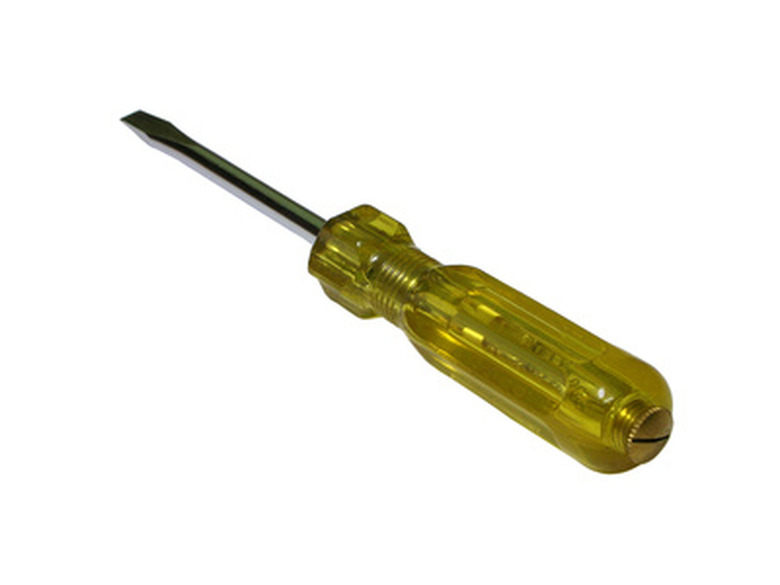How To Use Magnets To Conduct Electricity
As discussed in Halliday and Resnick's "Fundamentals of Physics," the magnetizable material in a transformer can serve to "conduct" electricity from one AC circuit to another that otherwise wouldn't have current. The primary circuit transfers its AC current into the transformer through a coil that exerts a magnetic field. This generates a magnetic field through the transformer. Alternating magnetic fields produce electromagnetic forces (emf). Because the primary's current varies, the magnetic field in the transformer varies. This generates an electromagnetic force in a coil in the secondary circuit, creating a secondary alternating current.
Step 1
Test a screwdriver or large bolt for magnetizability by seeing if a kitchen magnet sticks to it. Magnetizability is necessary for your homemade transformer to work.
Step 2
Wind one insulated wire around the metal part of the screwdriver, leaving at least half a foot of wire free at both ends. Scrape the tips of the wire bare, for making electrical contact later. The thinner the wire you use, the better, because you'll be able to fit more windings onto the screwdriver. The more windings, the better the magnetic field will conduct from one coil to the other.
Step 3
Wind the other wire around the metal part of the screwdriver. In both cases, the wires can overlap each other. Just keep track of which wire ends belong to the same wire. The more windings you can put in the wire, the stronger will be the conduction of magnetism through the screwdriver.
At this point, you will have two wires coiled around the screwdriver, and therefore four wire endings. In the next steps, you'll attach one wire's endings to the primary circuit and the other wire's endings to the secondary circuit.
Step 4
Purchase a lamp cord, complete with wall socket and bulb socket. Cut the cord in half. You should have one pair of parallel-running wires that attach to the bulb socket, and one pair of parallel-running wires that attach to the wall outlet plug. Slice the two newly formed ends down the middle, i.e. lengthwise, at least two inches to separate the parallel-running wires. Strip the ends of about an inch of insulation to expose the wire; do this for all four wires.
Step 5
Take one of the four bare wire ends coming from the screwdriver and twist tie it with one of the two bare wire ends of the lamp cord piece that still has a wall socket outlet attached. Once securely tied, use electrical tape to cover up these two wire ends, to avoid a short or a shock.
Step 6
Determine which of the three remaining bare wire ends coming off the screwdriver is the opposite end of the wire you just tied up (be sure to keep track of which ends belong to the same wire). Twist tie this bare wire end to the other bare wire end of the lamp cord piece that still has a wall socket outlet attached. Use the electrical tape again to cover it. This completes your primary circuit.
Step 7
Attach the two remaining bare ends coming off the screwdriver to the two bare ends of the lamp cord piece that still has the bulb socket attached. Use the electrical tape again to cover up bare wiring. This completes your secondary circuit.
Step 8
Screw a bulb into the bulb socket of the lamp cord. Insert the lamp cord's plug into a low-voltage AC source, i.e. something safer than a 110V wall socket. The reason for this is that the thin wire around the screwdriver may heat up too much if exposed to 110V AC. Lab supply stores sell transformers that plug into the wall and step down the voltage to relatively safe levels. 10V would be appropriate for this experiment.
Step 9
Turn the AC source on. The bulb will turn on, despite there being no electrical conduction between the primary and secondary circuits. The magnetizable metal of the screwdriver has therefore successfully conducted the electricity in the form of magnetic energy.
Things Needed
- Two insulated wires with bare ends (several feet)
- Screwdriver
- Light bulb
- Lamp cord
References
- Fundamentals of Physics; David Halliday and Robert Resnick; 1991
Cite This Article
MLA
Dohrman, Paul. "How To Use Magnets To Conduct Electricity" sciencing.com, https://www.sciencing.com/use-magnets-conduct-electricity-5880770/. 24 April 2017.
APA
Dohrman, Paul. (2017, April 24). How To Use Magnets To Conduct Electricity. sciencing.com. Retrieved from https://www.sciencing.com/use-magnets-conduct-electricity-5880770/
Chicago
Dohrman, Paul. How To Use Magnets To Conduct Electricity last modified March 24, 2022. https://www.sciencing.com/use-magnets-conduct-electricity-5880770/
